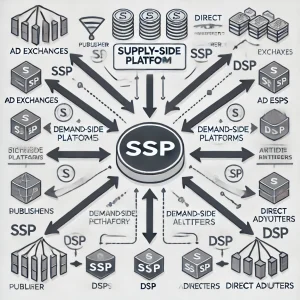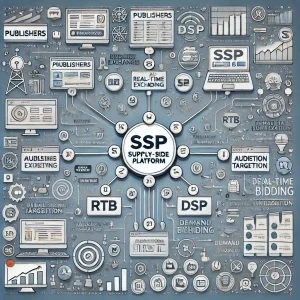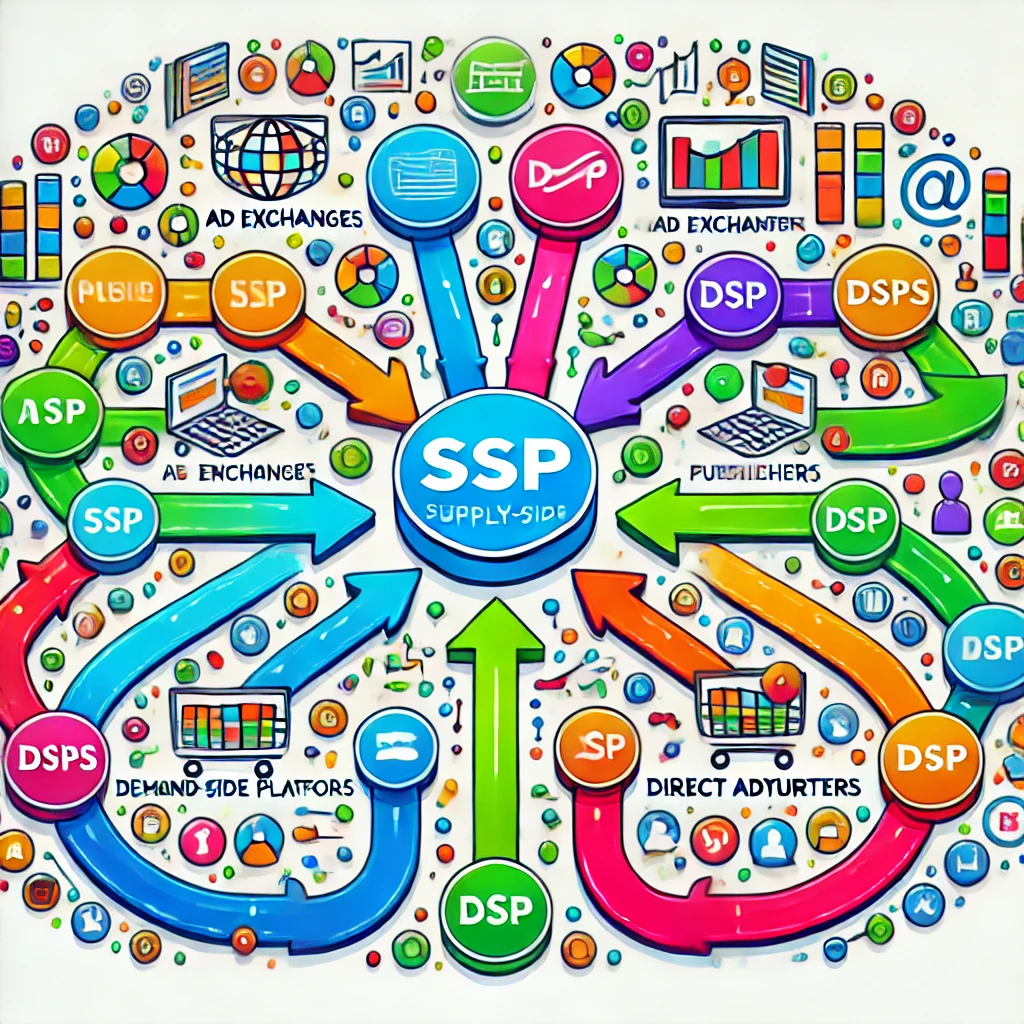Understanding Supply-Side Platforms (SSPs)
Maximizing ad revenue isn’t just about filling ad spaces. It’s about optimizing every aspect of your monetization strategy. Supply-Side Platforms (SSPs) provide the technology and data-driven insights publishers need to achieve this.
In this post, we will explore everything you need to know about SSPs and ad monetization.
[ez-toc]
Contents
What is a Supply-Side Platform (SSP)?
A Supply-Side Platform (SSP) is software that automates the sale of digital advertising space across various ad exchanges, networks, and demand sources. SSPs are central to the ad tech ecosystem, serving as the backbone of programmatic advertising, where ads are bought and sold in real-time.
SSPs are especially vital in dynamic environments like gaming monetization, where ad demand constantly fluctuates. They help publishers manage ad inventory in real-time, adapt to market conditions, and access a vast pool of advertisers. As digital advertising evolves, SSPs are becoming essential to the monetization strategies of publishers across websites, apps, and WebGL content.
Comparison to DSPs
SSPs and Demand-Side Platforms (DSPs) are both crucial to programmatic advertising, but they serve different purposes. SSPs are designed for publishers to sell ad space, while DSPs allow advertisers to purchase it.
When an ad impression becomes available on a publisher’s site or app, the SSP sends a bid request to multiple DSPs. These DSPs, representing advertisers, evaluate the request and bid based on audience targeting, ad relevance, and budget. The highest bid is accepted, and the ad is served on the publisher’s platform.
This interaction drives real-time bidding (RTB), a process at the core of programmatic advertising. SSPs ensure publishers get the best price for their ad inventory, as multiple DSPs compete for each impression. This competition not only boosts revenue but also allows for more sophisticated targeting, as advertisers pay more to reach their desired audience.
Key Functionalities of SSPs
-
Ad Inventory Management
Ad inventory management is a core function of SSPs. Effective management ensures that every ad slot is filled with the most profitable ads. SSPs give publishers tools to organize, categorize, and prioritize their ad inventory, whether across a mobile game, website, or other platforms.
SSPs prevent underutilization of ad space. Advanced algorithms expose every piece of inventory to potential buyers, increasing the likelihood of a sale. This is crucial in competitive markets like mobile game monetization, where each ad impression significantly impacts revenue.
-
Real-Time Bidding (RTB)
SSPs connect publishers with various demand sources, including ad exchanges, networks, and DSPs. When an ad impression becomes available, the SSP sends a bid request to potential buyers. These buyers bid on the impression based on targeting criteria and budget. The highest bid wins, and the ad is served instantly.
RTB through SSPs increases competition for ad space, driving up prices and revenue. It also allows for precise audience targeting, as advertisers pay more for impressions that match their desired demographics. This dynamic is especially beneficial in niche markets like web monetization and mobile game monetization, where targeted ads significantly boost engagement and revenue.
-
Yield Optimization
Yield optimization is crucial for ensuring publishers get the highest return on their ad inventory. SSPs use data analytics and algorithms to evaluate potential ad placements, selecting those that will generate the highest effective cost per thousand impressions (eCPM).
By leveraging yield optimization, publishers can improve their monetization strategies, ensuring their ad inventory is fully utilized and sold at the best possible rates. This is particularly valuable in environments where ad prices fluctuate rapidly, such as mobile advertising platforms and programmatic advertising.
-
Access to Multiple Ad Exchanges
One significant advantage of using an SSP is connecting with multiple ad exchanges simultaneously. An ad exchange is a digital marketplace where publishers and advertisers buy and sell ad inventory. By linking to several ad exchanges, SSPs increase a publisher’s inventory exposure, enhancing competition among buyers.
Connecting to multiple ad exchanges also helps publishers reduce the risk of unsold inventory. If one exchange doesn’t have demand for a particular ad slot, another might. This broad access is beneficial in niche markets, such as WebGL monetization or mobile game ads, where finding the right buyers can make a significant revenue difference.
-
Audience Targeting
Audience targeting is a powerful SSP feature that enhances the relevance and effectiveness of ads served on a publisher’s platform. By using data like demographics, user behavior, and device type, SSPs enable publishers to deliver highly targeted ads that resonate with specific audience segments.
SSPs also allow publishers to offer advertisers more granular targeting options, which can command higher prices. Advertisers often pay a premium for ad placements that reach their exact target audience, making audience targeting a critical component of any successful monetization strategy.
-
Reporting and Analytics
Detailed reporting and analytics are essential for refining monetization strategies. SSPs provide publishers with comprehensive insights into their ad performance. These platforms offer real-time data on metrics like impressions, clicks, eCPM, and overall revenue. This data allows publishers to track the success of their ad placements and make informed decisions. Following on Understanding Supply-Side Platforms (SSPs): Part 5, i will talk about how publishers can maximize revenue.
How SSPs Maximize Publisher Revenue
-
Increasing Demand Competition
SSPs maximize publisher revenue by increasing demand competition for their ad inventory. SSPs connect publishers with a vast network of potential buyers, including ad exchanges, DSPs, and direct advertisers. By exposing ad inventory to multiple buyers simultaneously, SSPs create a competitive bidding environment where each buyer strives to outbid the others for ad impressions.
This competition drives higher prices for ad inventory. When more buyers are interested in the same ad space, bidding wars push up the cost per thousand impressions (CPM), resulting in higher revenue for the publisher. For instance, in mobile game monetization, where ad space is highly sought after, SSPs can significantly enhance ad revenue by attracting multiple advertisers to bid on in-game advertising slots. The same principle applies to content monetization on websites, where increased demand competition leads to higher web monetization returns.
-
Advanced Targeting and Data Usage
 SSPs use advanced targeting capabilities and audience data to enhance ad relevance and engagement. By using data from sources like user behavior, demographics, device types, and geographic locations, SSPs help publishers deliver highly targeted ads that resonate with specific audience segments.
SSPs use advanced targeting capabilities and audience data to enhance ad relevance and engagement. By using data from sources like user behavior, demographics, device types, and geographic locations, SSPs help publishers deliver highly targeted ads that resonate with specific audience segments.
SSPs also use machine learning algorithms and real-time data processing to refine and optimize targeting strategies. This dynamic approach ensures ads remain relevant, even as user behavior or market conditions change. For publishers, this means consistently higher engagement rates and more effective monetization strategies, as targeted ads command higher CPMs compared to generic ones.
-
Premium Demand Partnerships
Premium demand partnerships can significantly boost a publisher’s revenue by attracting advertisers looking to place ads in specific contexts or on platforms with high user engagement. For instance, in video monetization platforms, premium advertisers might place ads in pre-roll or mid-roll positions within high-traffic video content. These ads often command much higher CPMs than standard display ads due to their format, placement, and the quality of the content they are associated with.
Challenges and Considerations When Using SSPs
-
Transparency Issues
Following on Understanding Supply-Side Platforms (SSPs): Part 5 Post, Transparency in the SSP ecosystem is a critical concern for publishers. The complexity of programmatic advertising can lead to a lack of transparency regarding how ad inventory is sold, who buys it, and at what price.
A primary transparency issue revolves around the “black box” nature of many programmatic transactions. Publishers often struggle to gain clear visibility into the auction process, including bids received, the final sale price of ad impressions, and fees deducted by intermediaries. This opacity makes it challenging for publishers to understand how their ad inventory is monetized and whether they receive fair value for their impressions.
Understanding the revenue share model used by an SSP is crucial for publishers. SSPs typically take a percentage of the ad revenue generated from selling a publisher’s inventory. This cut varies depending on the SSP, the type of ad inventory, and the partnership agreement.
Publishers should ensure they fully understand the terms of the revenue share model before entering into an agreement with an SSP. Some SSPs might charge higher percentages but offer additional services like advanced targeting, premium demand partnerships, or better yield optimization tools. However, if the SSP’s cut is too high, it could significantly reduce the publisher’s net revenue, especially in competitive markets like mobile game monetization or web monetization.
To navigate these challenges, publishers should carefully review and negotiate the terms of the revenue share model, ensuring they get the best possible deal. It’s also advisable to compare multiple SSPs and evaluate their offerings based on not just the percentage they take but also the value they provide in terms of revenue generation, transparency, and additional services.
-
Ad Fraud and Brand Safety
Ad fraud and brand safety are two significant challenges in digital advertising that directly impact publisher revenue. SSPs play a crucial role in addressing these issues. Ad fraud, involving activities like bot traffic, fake ad clicks, or misrepresentation of ad inventory, can lead to substantial revenue losses for publishers. When advertisers pay for fraudulent impressions or clicks, they are less likely to invest in the affected publisher’s inventory in the future, leading to reduced demand and lower ad prices.
SSPs are increasingly incorporating advanced technology and partnerships with third-party verification services to combat ad fraud and ensure brand safety. Many SSPs use sophisticated algorithms and machine learning to detect and filter out fraudulent traffic before it impacts ad campaigns.
AppLixir Rewarded Video Ad Monetization
Before I finish Understanding Supply-Side Platforms (SSPs): Part 5 post, SSPs empower publishers by providing an efficient method to manage and sell ad inventory. These platforms facilitate programmatic advertising, where ad inventory is sold through automated auctions rather than traditional, manual negotiations. By leveraging SSPs, publishers can optimize their content monetization strategies, ensuring that every ad impression is sold to the highest bidder, thus maximizing revenue.
AppLixir is a leading platform for rewarded video ads that helps publishers maximize their ad revenue while maintaining a seamless user experience. By integrating AppLixir, publishers can effortlessly offer non-intrusive, high-quality video ads that engage users and increase monetization. Whether you’re focused on mobile games, web apps, or content platforms, AppLixir’s robust tools and advanced targeting ensure that your ad inventory reaches the right audience at the right time, driving higher eCPM and enhancing overall revenue performance.



